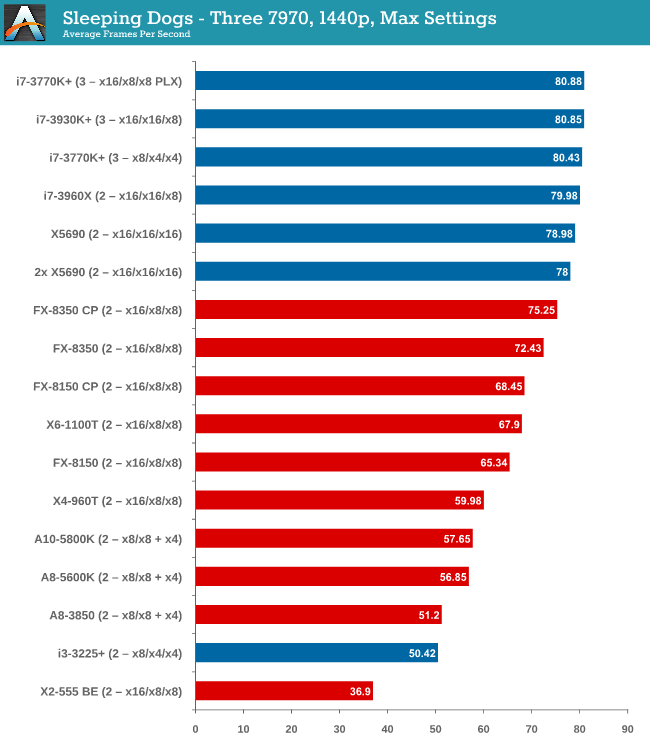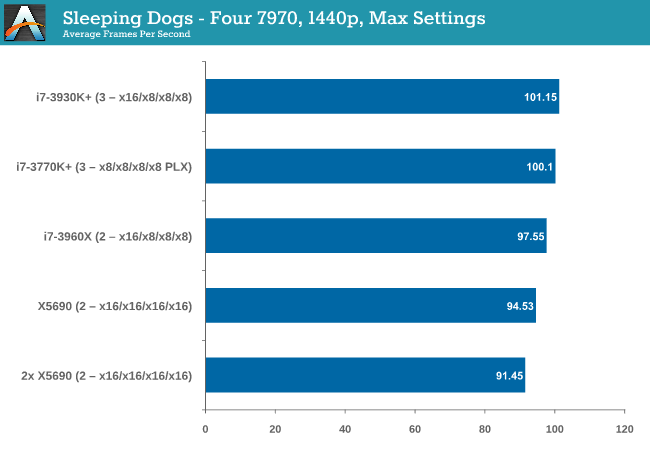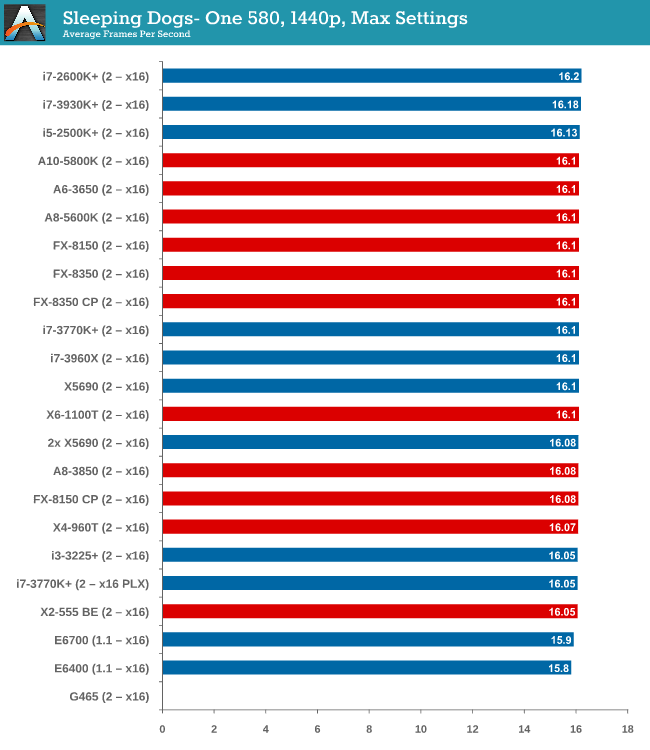Choosing a Gaming CPU: Single + Multi-GPU at 1440p, April 2013
by Ian Cutress on May 8, 2013 10:00 AM ESTSleeping Dogs
While not necessarily a game on everybody’s lips, Sleeping Dogs is a strenuous game with a pretty hardcore benchmark that scales well with additional GPU power. The team over at Adrenaline.com.br are supreme for making an easy to use benchmark GUI, allowing a numpty like me to charge ahead with a set of four 1440p runs with maximum graphical settings.
One 7970

Sleeping Dogs seems to tax the CPU so little that the only CPU that falls behind by the smallest of margins is an E6400 (and the G465 which would not run the benchmark). Intel visually takes all the top spots, but AMD is all in the mix with less than 0.5 FPS splitting an X2-555 BE and an i7-3770K.
Two 7970s

A split starts to develop between Intel and AMD again, although you would be hard pressed to choose between the CPUs as everything above an i3-3225 scores 50-56 FPS. The X2-555 BE unfortunately drops off, suggesting that Sleeping Dogs is a fan of the cores and this little CPU is a lacking.
Three 7970s

At three GPUs the gap is there, with the best Intel processors over 10% ahead of the best AMD. Neither PCIe lane allocation or memory seems to be playing a part, just a case of threads then single thread performance.
Four 7970s

Despite our Beast machine having double the threads, an i7-3960X in PCIe 3.0 mode takes top spot.
It is worth noting the scaling in Sleeping Dogs. The i7-3960X moved from 28.2 -> 56.23 -> 80.85 -> 101.15 FPS, achieving +71% increase of a single card moving from 3 to 4. This speaks of a well written game more than anything.
One 580

There is almost nothing to separate every CPU when using a single GTX 580.
Two 580s

Same thing with two GTX 580s – even an X2-555 BE is within 1 FPS (3%) of an i7-3960X.
Sleeping Dogs Conclusion
Due to the successful scaling and GPU limited nature of Sleeping Dogs, almost any CPU you throw at it will get the same result. When you move into three GPUs or more territory, it seems that having the single thread CPU speed of an Intel processor gets a few more FPS at the end of the day.










242 Comments
View All Comments
iamezza - Thursday, May 9, 2013 - link
I have 3 x 1080p and a 7970, on modern games it isn't possible to get 60fps without turning settings way down. Really need 2 x 7970 to maintain 60+ fpsTheInternal - Saturday, May 11, 2013 - link
I'm guessing it does 30+ FPS comfortably though?Arnulf - Wednesday, May 8, 2013 - link
Are you retarded or just an imbecile ?marc1000 - Wednesday, May 8, 2013 - link
good work Ian!that's a LOT of data, but the best part is the explanation of WHY. hope it makes matters clear.
side note: it was nice to see the link to www.adrenaline.com.br ! those guys are insane indeed! =D
Doomtomb - Wednesday, May 8, 2013 - link
I have an i7-875K. I would like you to include an i7 from the Westmere/Nehalem generation. Thanks!mapesdhs - Monday, May 20, 2013 - link
I'm doing lots of tests that should help in your case. If you want me to test anything specific,
feel free to PM. I have the same 875K, but also 2500K, 2700K, 3930K, Ph2 965, QX9650
and many others.
Ian.
Pheesh - Wednesday, May 8, 2013 - link
I'm really surprised that minimum FPS wasn't also tested. Testing just for average FPS is not that informative to the actual experience you will have. If given the choice between two CPU's I'd take one averaging 70 fps but with a minimum fps of 50 over one that averages 80fps but has a minimum fps of 30.mip1983 - Wednesday, May 8, 2013 - link
Perhaps some games are more CPU limited, I'm thinking MMO's like Planetside 2 were there are a lot of players at once. Not sure how you'd benchmark that game though.bebimbap - Wednesday, May 8, 2013 - link
Ian I know you are a BL2 fan. The game is written with a old UT engine i'm told, so it's performance scaling isn't the same as some of these other titles. The method of testing you used was similar to how I buy my own equipment and recommend to others.With my same 3770k clocked at stock 3.9ghz I can only get about 57fps with my gtx670. when it is OC'd to 4.7ghz that same scene now becomes GPU limited at 127fps on my 144hz lcd. I'm glad you posted this. When people ask for my advice on what hardware to buy, I always tell them, that they should aim for a resolution first, 1080p for example, then what game they would want to play and what performance presets, mid settings 120hz, then buy a gpu/cpu combo that compliments those settings. if your budget allows then up the hardware a tier or two. Too many times do I see people just buy a top tier GPU and wonder why their fps is lower than expected. My way your expectations are met, then if budget allows, are exceeded. I hope you start a trend with this report. So that others can go this route when performing upgrades.
Michaelangel007 - Wednesday, May 8, 2013 - link
The article is a good start! Pity it didn't include the Tomb Raider benchmark that anyone can run, nor include a discussion about the badly implemented Windows timer frequency that Lucas Hale documented with his "TimerResolution" program. HyperMatrix found lowering the default timer resolution from 10ms down to 1 ms allowed for "Crysis 3 - 30% Framerate and Performance"